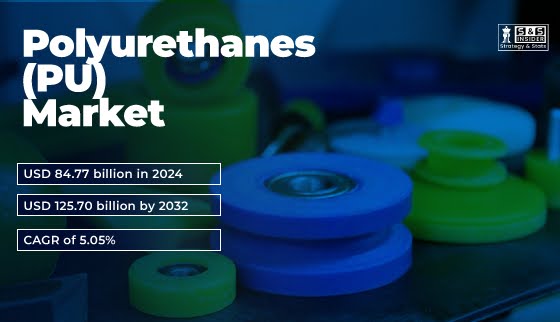The Polyurethanes Market size was USD 84.77 billion in 2024 and is expected to reach USD 125.70 billion by 2032, reflecting a promising growth trajectory. Driven by increasing demand across diverse end-use industries, polyurethanes have emerged as a critical material in construction, automotive, furniture, electronics, and packaging applications. Their unique characteristics, including high durability, flexibility, chemical resistance, and energy efficiency, make them a preferred choice among manufacturers seeking advanced materials for innovative applications.
Polyurethanes Market: Polyurethanes are widely used in rigid and flexible foams, coatings, adhesives, sealants, and elastomers, each offering distinct advantages to various industrial processes. The expanding construction sector is a primary contributor to market growth. Insulation materials made from polyurethane foams help improve energy efficiency in residential and commercial buildings, aligning with global sustainability initiatives. Moreover, in the automotive industry, polyurethanes are increasingly used for seating, interior panels, and lightweight components, supporting vehicle electrification and fuel efficiency goals.
Key Drivers Fueling Market Expansion
One of the primary drivers of growth in the polyurethanes industry is the rising adoption of lightweight materials in automotive and aerospace applications. Manufacturers are under increasing pressure to reduce vehicle weight to meet stringent emission norms, and polyurethane components provide an effective solution without compromising performance. Furthermore, advancements in bio-based polyurethanes and sustainable production processes are encouraging manufacturers to adopt eco-friendly alternatives, thereby widening market potential.
The construction sector continues to be a robust driver for polyurethanes. The growing emphasis on energy-efficient and green buildings has led to higher demand for polyurethane insulation materials, which offer superior thermal performance compared to conventional options. Additionally, polyurethane coatings are increasingly utilized for industrial equipment, pipelines, and infrastructure due to their resistance to corrosion, abrasion, and chemical degradation, extending asset life and reducing maintenance costs.
Another factor driving the market is the surge in demand from the furniture and bedding industries. Flexible polyurethane foams are extensively used in mattresses, sofas, and cushions due to their comfort, resilience, and long-lasting properties. Rising disposable incomes, urbanization, and a growing preference for premium furniture in emerging economies are further contributing to market expansion.
Technological Innovations and Industry Trends
Innovation in polyurethane chemistry is opening new avenues for applications. High-performance polyurethane elastomers, thermoplastic polyurethanes, and hybrid materials are gaining traction across multiple sectors. For instance, thermoplastic polyurethanes are increasingly utilized in 3D printing, flexible electronics, and medical devices due to their excellent mechanical properties and processability.
Research and development efforts are also focusing on bio-based polyols, which reduce dependency on fossil fuels and align with sustainability goals. This trend is expected to play a significant role in shaping the market landscape in the coming years. Companies are investing in R&D to enhance product performance, reduce environmental impact, and meet the evolving needs of various industries, including automotive, healthcare, and electronics.
Market Outlook
The Polyurethanes Market size was USD 84.77 billion in 2024 and is expected to reach USD 125.70 billion by 2032, growing at a CAGR of 5.05% over the forecast period of 2025-2032. This growth reflects both the versatility of polyurethanes and the rising global demand for sustainable, high-performance materials. Manufacturers that can leverage technological advancements and sustainability trends are expected to gain a competitive edge in this expanding market.
The increasing adoption of polyurethanes in emerging economies, driven by rapid urbanization, infrastructure development, and industrial expansion, is anticipated to further support market growth. Moreover, regulatory initiatives promoting energy efficiency, green building practices, and the use of eco-friendly materials are expected to accelerate the adoption of polyurethanes across multiple applications.
In conclusion, the polyurethanes industry is poised for sustained growth over the next decade. Driven by innovations, sustainability trends, and increasing demand across various end-use industries, the market is set to witness significant expansion. Companies investing in research, technological advancements, and eco-friendly solutions are well-positioned to capitalize on this growth, shaping the future of the polyurethanes market.
FAQs
Q1: What is the expected CAGR of the polyurethanes market?
A1: The market is projected to grow at a CAGR of 5.05% from 2025 to 2032.
Q2: What is the forecasted size of the polyurethanes market by 2032?
A2: The market is expected to reach USD 125.70 billion by 2032.
Q3: Which regions are likely to drive growth in the polyurethanes market?
A3: Emerging economies in Asia-Pacific and ongoing demand in North America and Europe are expected to be the primary growth drivers.

